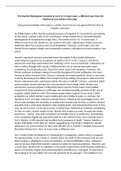‘The Hamlet Shakespeare presents in Act V is, in many ways, a different man from the
Hamlet we saw earlier in the play.’
Using your knowledge of the play as a whole, show how far you agree with this view of
Hamlet’s character.
Sir Phillip Sidney writes that the principal purpose of tragedy is to ‘teacheth the uncertainty
of this world.’ Indeed, much of the ‘uncertainty’ within Hamlet lies in characterising the
development of its eponymous tragic hero. The Hamlet of Act V is, ‘in many ways, a
different man from the Hamlet we saw earlier in the play’, appearing to finally overcome
indecision after four torturous acts of contemplation. However, by the play’s end, the
Danish Prince remains volatile and emotionally unstable, indicating his transformation is not
entire.
Hamlet’s agonised musing is presented most thoroughly in his suicidal soliloquies,
contrasting his equanimous acceptance of death in Act V. In Act 1 Scene 2, the Prince
desires the relief that would follow the ‘melt[ing]’ of his ‘too too solid flesh.’ Ultimately, he
fails to follow through with suicide, inhibited by the fear of eternal damnation upon
considering ‘the Everlasting had… fixed/ His canon ‘gainst self-slaughter.’ However, the
Prince continues to debate ending his own life throughout his later soliloquies, the most
famous of which is found in Act 3 Scene 1, whereby he simply questions ‘to be or not to be.’
A strong dramaturgical tradition has emerged of using setting and props to underscore the
Prince’s depressed state, particularly within the early to mid-20 th century, a period in which
psychoanalysis became perhaps the most dominant lens through which Hamlet was
interpreted. Laurence Olivier’s 1948 performance saw the Prince hold a ‘bare bodkin’
towards him whilst standing at a cliff-edge, the sea below possibly symbolic of the ‘sea of
troubles’ within Hamlet’s mind. This representation likely inspired Trevor Nunn’s 2004
production, in which Hamlet is seen holding pills and a bottle of water. In contrast, the
Hamlet of Act V no longer expresses suicidal desires. Following the Gravedigger Scene, the
Prince acknowledges the mortality of mankind and accepts that his time on earth is limited.
Arguably, this is what leads Hamlet to stop seeking death, who instead declares that ‘if it be
now, tis not to come; if it be not to come, it will be now.’ Rather than fruitlessly questioning
his fate on earth, Hamlet resigns to the ‘divinity that shapes our ends’ through the simple
statement – ‘Let be.’ This calm acceptance of mortality serves to undermine, and perhaps
even completely negate the argument made by critic Andrew Foley, who contends that in
Act V, Hamlet ‘is still haunted and horrified by the prospect of death.’ Indeed, Hamlet no
longer soliloquises in the final act, further suggesting he is no longer crippled by suicidal
depression nor concerned for his fate in the afterlife. Thus, Hamlet’s changed mental state
illustrates that by Act V, he is ‘in many ways, a different man.’
Act V marks further development in Shakespeare’s protagonist, whose inertia is swapped
for decisive action. In Act 3 Scene 2, Hamlet states he could ‘drink hot blood/ And do such
bitter business’, alluding to a sense of resolution. As Michael Billington notes, audiences
new to the play might think Hamlet is about to realise his regicidal ambitions. However, just
a scene later, Hamlet fails to capitalise on the perfect opportunity to kill Claudius whilst he is
alone in his private chapel, and instead questions whether he is ‘revenged/ To take him in
the purging of his soul,/When he is fit and seasoned for his passage?’ This inability to act




